Update: Humbled by all the feedback and comments: Check out the great discussion spawned on the Hacker News thread Summary/Table of Contents
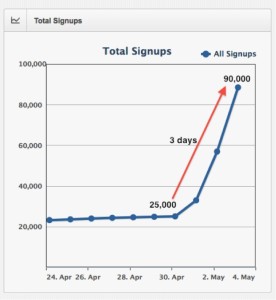
Our product recently hit a tipping point, signing up over 60K users in less than 60 hours, despite not being a naturally viral experience. While we were obviously trying to grow, this was much faster growth than we ever expected. I’m writing this post to break down where the traffic actually came from and what we learned from the experience so other startups can apply some of our lessons to their own products. I broke the post down into sections so you can skim and skip to the parts you’ll find interesting and helpful.
- Intro/Background: This is a quick background on our product and what we did leading up the rapid growth. Read this is you want a better frame of reference for the data.
- Sec 1: Breakdown of the Data: In this section I’ll break down where all our traffic and users actually came from, so you can tell how different sources bring different levels of traffic quality. If you’re not interested in the data, you can skip this and go right to the lessons we learned.
- Sec 2: Lessons You Can Apply to Your Product (what we learned): In this section I break down a few lessons we learned from the experience, so you can apply them to your own product.
- Conclusion/Discussion points: The point of this article is to start a discussion and hopefully give other founders an ideas to market their own product. This section will give some starting points for the comments section.
Intro/Background
My company, BrandYourself.com, built a product that helps people improve their own search results. While we’ve always strongly believed in the importance of our product – my co-founder Pete couldn’t get an internship in college because he was being mistaken for a drug dealer in Google – we also understood that we don’t have the same natural viral stickiness as a game like Draw Something or a social network like Instagram (I’ve always (half) joked to investors that we’re more TurboTax than we are Facebook). So when we launched our product in mid-March, we were only expecting a moderategrowth rate. I would have been happy with 100K users by the end of 2012. To our surprise, we surpassed 100K users in less than 3 months after hitting a tipping point in the beginning of May. On May 1st we announced a new feature: the ability to see which companies or employers are Googling you and finding your profile. We were hoping the announcement would generate some press and a few thousand new users. Instead, between May 1 and May 3, we had 180K new visits and signed up 60K new users at a 30% conversion rate. Here is a breakdown of where they came from, and what made this push so different.
Sec 1: Breakdown of the Data (where users came from)

1.) Not all Mashable articles are created equal: This was the first time an article about us trended on Mashable’s first page, and it made an exponential difference. On May 1, Mashable wrote an article on our new feature that ended up being much more popular then we expected. It received nearly 13K shares, 40 comments and trended on their first page for two days. We always knew Mashable was a great source of traffic (they covered our launch in March), but we didn’t know how much of a difference it can make if the article remains on their first page for an extended period of time. To give you a comparison, here’s the difference between the Mashable article that trended vs. the older Mashable article that didn’t.
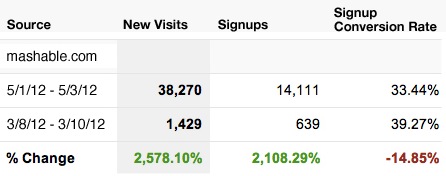
As you can see from the 3/8/12 article, we were expecting 500-1,000 signups from a Mashable feature. In this case we received close to 15k signups (over 25x more) and almost 40x more traffic. While you would expect the more popular articles to receive more traffic, the discrepancies between the two articles is much larger than I ever would have imagined. 2) Because of the popularity of this Mashable article, other major publications began picking up the story. Once the Mashable article trended for two days, other MAJOR publications — The Huffington Post, Yahoo Finance, etc. — began covering the story as well, linking to the original Mashable article as the source.
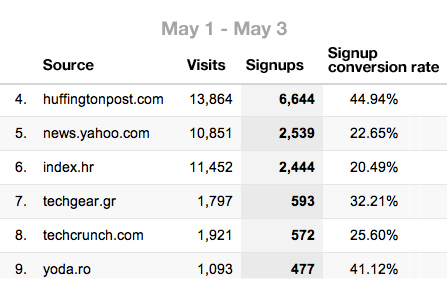
Interesting point #1: As any startup will tell you, most publications will only feature a startup if given some sort of exclusive. In their eyes, the only reason to cover a startup is if it provides readers with something they can’t get anywhere else. However, that’s not the case if the story is perceived as popular/newsworthy enough (trending on Mashable). If that’s the case, they’ll cover it anyways, so it doesn’t seem like they missed a big story.
Interesting point#2: As you can see in the screenshot above, we were also picked up by major publications in Europe and South America. I never pitched these places so they must monitor sources like Mashable for interesting stories. The interesting thing is, even though our site is in English and their articles about us were not, our conversion rate of free signups was still insanely high; in fact, at over 40%, they converted higher than most domestic sources. At first I worried these might have been questionable users (bots, spammers, etc.), but upon digging deeper it was clear they were legimate signups. *Important Note: The TechCrunch article written about us was actually pitched directly, and was NOT a case of them simply poaching Mashable’s story.
Interesting Point #3: All these new users began sharing BrandYourself, which compounded growth even more. While we’re used to tweets and status updates here and there, we literally had thousands and thousands of updates every day from people recommending the service, bragging about their BrandYourself Search Score, etc.



While we can only correlate tweets, status updates, etc. to a few thousand signups directly, the thousands of updates mixed in with all of the articles probably played a part in the next major sources of signups: Direct, and Google.
2) Signups from Direct sources and direct Google searches sky-rocketed.

While you’d obviously expect our search volume and direct traffic to increase after getting press coverage, the difference is staggering. Compared to the same 3-day period the week before, we had 70,000 more visits (a 23,000% increase) and over 25,000 more signups (a 35,000% increase). All our organic traffic from Google came from people searching for variations of our company name (brand yourself, brandyourself.com, etc). So even if all the press and tweets didn’t directly sign people up on the spot, they were enough to bring people back to signup later. All of this created a huge Long Tail effect. While some of the bigger press mentions accounted for a large chunk of our signups and traffic, we had 445 sites that made up almost 10,ooo signups. 360 of those sites signed up less than 10 people a piece. These sources were a mixture of:
- User’s BrandYourself profiles. Every BrandYourself profile links back to our main site, and with so many more users, we had hundreds of BrandYourself profiles that began sending us more and more signups. Here’s the traffic from one user’s profile:

- Personal Blog Posts: Our own users began writing about us on their personal blogs, like this one. (Never a bad sign when users are willing to do that).
- Smaller foreign blogs began picking up the story, like this one.
Again, while none of these were major sources compared to some of the bigger press pieces, collectively they made up a big chunk. To put it in perspective, these long tail sites alone would have increased our users by 50% in that small 3 day period.
Sec 2: Lessons you can apply to your product (what we learned):
While there’s no way to guarantee you’ll get featured in a major publication and have that article become wildly popular, I do believe there are a few lessons from this that anyone can apply when marketing their own product. Disclaimer: I also understand this doesn’t necessarily apply to all types of products or services. This is just what we learned in from ours:
1) Promote one feature at a time. Make sure it’s the one people care about. We released a dozen features on May 1. However, every pitch I wrote that included everything seemed long, hard to read, and quite frankly, boring. The really exciting feature, the one that consumers would actually care about – the fact that BrandYourself can now tell you when specific companies or employers Google you – was getting lost in boring stuff. By ditching everything else and focusing on that one element, the pitches, and subsequent stories, wrote themselves and we were able to get great coverage that people read, shared and talked about. If it wasn’t so focused, I don’t believe we would have been picked up at all. Even if we were, I don’t think it would have created the same amount of excitement.
2) Pitch the right publication to make your announcement (choose very wisely). When you’re a startup, usually only one major blog or publication is going to cover you (if any), so you want to get the biggest bang for your buck. You need to know who’s going to use your product and care about this story the most. Is it techies (TechCrunch readers)? The self-improvement crowd (LifeHacker)? PR pros (PR Week)? We’ve been covered in many places, and we’ve been able to identify Mashable readers as the best audience for us: their traffic signs up at the highest rate, and they lead to the most paying members. This is why we pitched them first. It ended up being a good decision: the article recieved 14K shares, led to 15K signups and led to other major coverage like the Huffington Post (see the Data Breakdown in Sec 1 in case you skipped ahead).
3) Focus the story on specific people, not on your company or product. You have to face the facts: nobody cares about your startup. They don’t care how hard you work, how much money you raised or even how brilliant you are. They especially don’t care that you just released a feature, unless of course, that feature will make their life better. The story I pitched had almost nothing to do with BrandYourself. It was completely centered around the fact that people could now understand who was Googling them online. I used an advertising student going on job interviews as an example. That’s what makes it exciting and worth reading. That’s what makes it newsworthy. If I didn’t focus on how this was going to be used by tons of people, there is no way it would have been newsworthy to be picked up by so many places (see the breakdown in Sect 1 in case you skipped ahead).
4) Focus on your signup flow (optimize conversions). Traffic doesn’t mean anything if you can’t get them to complete an action – in this case, sign up for a free account. We literally spent months perfecting our signup flow, making the product easy to sign up for and easy to get started. We tweaked the language until the value proposition was absolutely clear. We tweaked the first few steps to make sure we didn’t overwhelm people with too much upfront. We tweaked our navigation so we gave users the right amount of information they needed to make a decision, without overloading them. 
Did it make a difference? Signing up 8% of traffic for a free software like ours is considered good. We converted 30%. If we had settled for just 8%, we would have had 40K less signups.
5) Understand where and how your product can be viral (even if it isn’t a social network). This is really important. Even if you aren’t a game or a social network meant to be shared with friends, people will always share an interesting experience. Depending on how your users view your product, there are different reasons someone might share it. The trick is understanding what type of methods will work for you. It could be financial incentives (Dropbox does this by giving you free space), it could be game mechanics (AppSumo lets you share contests to give you a better shot at winning) or it could simply be a way to let users thank you for creating a great experience (if you like our product, do us a favor and tell your friends). We based our viral tools on two important discoveries:
People like bragging to their friends about accomplishments and recommending new services. We let people share their achievements, like owning their entire first page of search results or making their website 15% more likely to show up higher in Google. This is a great way to let users share their experience in a way that entices their friends to try it.


Users profiles send very high quality traffic. Users can publish a BrandYourself profile, which usually show up high in their Google results. As more and more people created profiles, those profiles became a top ten source of new paying members. Someone will Google one of our users (possibly an employer), find their BrandYourself profile, and end up wanting one themselves. Once we learned this, we increased profile traffic even more by adding a strip on the top of profiles advertising the service (premium members can remove this strip).
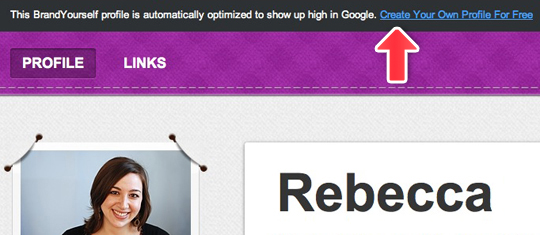
There’s an old advertising saying: “the fastest way to kill a bad product is good advertising.” All the press or traffic in the world doesn’t matter if your product is confusing, hard to signup for, or under-delivers. More than anything else, we’ve worked hard to create a product that helps people solve a real problem. We worked hard to make sure we are absolutely the best thing out there. We literally get dozens of emails a day about how we’ve improved somebody’s life.
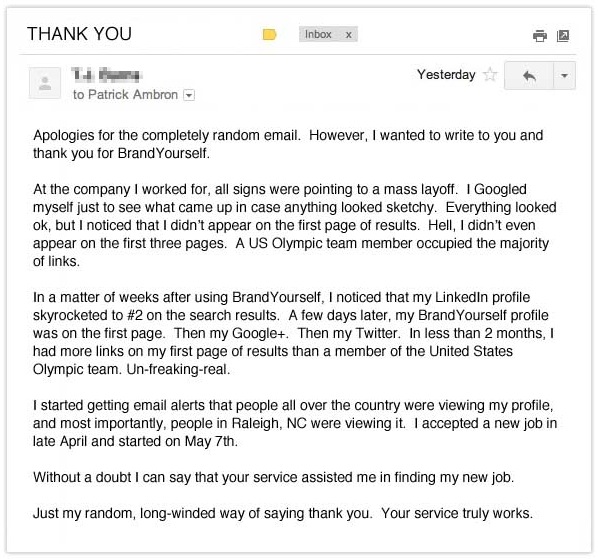
The points is: once we get you to sign up, we’ve done the hard part. You’ll have a great experience and there is no marketing tool more powerful than that.
Conclusions/Discussion Points
As a quick recap: We released a new feature, it got covered by Mashable, and the article ended up being very popular and highly shared. Not only did this lead to even more converage in other places, but singing up so many more users so quickly created a viral bump as more and more users shared the product with their friends. Since the point of this post is to help other founders with ideas to market their own product, I figured we should end with some discussion points. Feel free to comment on the post with your thoughts and feedback.
- We were genuinely impressed by how much more traffic a trending Mashable article was able to generate. Which sources have brought the most traffic to your sites? Any surprises?
- We talked about figuring out which type of viral hooks to use in your product, like sharing achievements. Do you have any examples of viral hooks that have worked for you?
- Do you have any other tips for founders trying to promote their consumer web product?
Thanks again for reading and hopefully you found this helpful.

